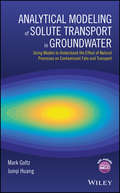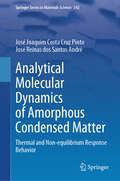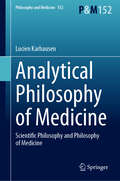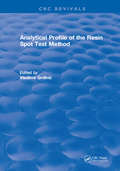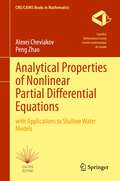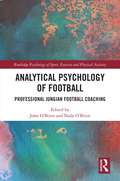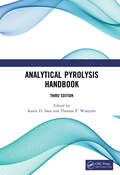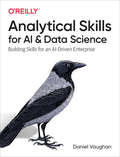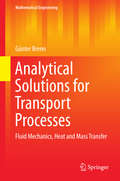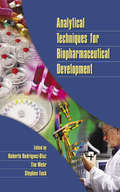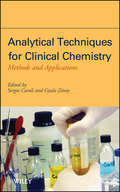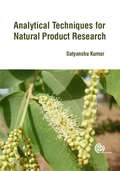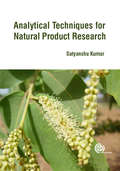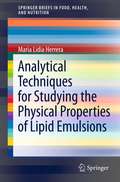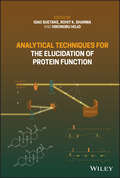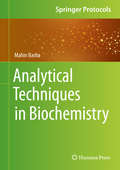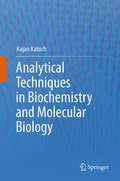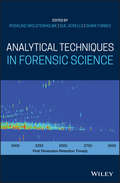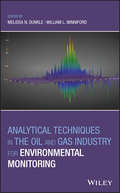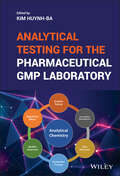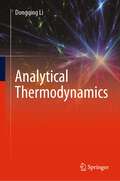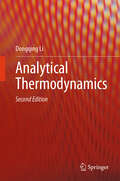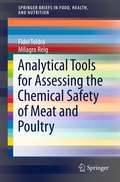- Table View
- List View
Analytical Modeling of Solute Transport in Groundwater: Using Models To Understand The Effect Of Natural Processes On Contaminant Fate And Transport In Groundwater
by Junqi Huang Mark GoltzTeaches, using simple analytical models how physical, chemical, and biological processes in the subsurface affect contaminant transport Uses simple analytical models to demonstrate the impact of subsurface processes on the fate and transport of groundwater contaminants Includes downloadable modeling tool that provides easily understood graphical output for over thirty models Modeling tool and book are integrated to facilitate reader understanding Collects analytical solutions from many sources into a single volume and, for the interested reader, shows how these solutions are derived from the governing model equations
Analytical Molecular Dynamics of Amorphous Condensed Matter: Thermal and Non-equilibrium Response Behavior (Springer Series in Materials Science #342)
by José Joaquim Costa Cruz Pinto José Reinas dos Santos AndréThe book provides a detailed quantitative study and characterization of the physics of the thermal and viscoelastic behavior of mainly amorphous materials, and addresses a readership of both undergraduate (Part I and the two first chapters of Part II) and graduate students and junior researchers (Parts II and III). Though the discussion and examples concentrate on polymer materials, Part II illustrates the potential universality of the proposed most recent treatment – a Cooperative Theory of Materials Dynamics (CTMD) – and its ability to portray the 11 major physical characteristics of the materials' behavior by an alternative view of the thermal equilibrium and non-equilibrium dynamics at the "micro-scale", the still challenging problem of the glass transition and glass transition temperature, how partial crosslinking or crystallization limits the response, the expected impact of molecular packing, and of a few other open challenges. Part III discusses three specific domains where new applications and extensions of CTMD might be explored, while three Appendixes collect a few quantitative details and extensions of the treatment.
Analytical Philosophy of Medicine: Scientific Philosophy and Philosophy of Medicine (Philosophy and Medicine #151)
by Lucien KarhausenThis book describes the philosophy of medicine as a subset of the philosophy of science. It is grounded in an epistemological bottom-up account that arises from the clinical situation, the epidemiologic and the resulting public health account. The volume offers a set of coherent beliefs that are deductively closed, which means that any statement which is logically entailed by the theory belongs to the theory. Medicine does not originate, as usually admitted, with the notion of disease inasmuch as concepts of disease, malfunction or health are evolved, sophisticated and advanced constructs. Medical norms, i.e., pathological features, are logically and conceptually prior to normal features. Following Ludwig Wittgenstein, by analogy with the way members of a family resemble each other, diseases are often what Ludwig Wittgenstein called “family-resemblance concepts”, which manifest a similarity shared by things classified into certain groups in the way members of a family resemble each other: each shares characteristics which many but not all the others, and there are no necessary or sufficient conditions for belonging in that classification. This book analyses the confusions associated with the concept of health, and subsequently turns to medical interventions, preventive, therapeutic and palliative as well as to the caring relationship, patients’ autonomy, doctors’ authority, and paternalism. Finally, the epistemic, ethical, or ontological limits of medicine, are being discussed, and the final account leaves us at the end of the scale with the perspective afforded by the patient facing suffering, impairment, death and tragedy, not to mention the physician’s predicament, which give rise to the principle that undergirds them all, i.e., the value of life.
Analytical Profile of the Resin Spot Test Method
by Vladimir GrdinicThe working title of the book was The Detection of Analytes by the Resin Spot Tests Method. Firstly, we decided to sort out all published qualitative methods systematically against analytes. We were not discouraged by the obstacles, such as the study of a great number of papers published in Japanese, the difficulty in locating (especially older) publications, or the time required. Still, having in mind not to burden unnecessarily the volume of the book, we dismissed the idea of systematically listing all the procedures in detail. Nevertheless, a relatively large number of them found a place in the book, and perhaps this will contribute to the stirring of spontaneous interest in this technique in the ranks of applied chemists and others who a priori shun the technique.
Analytical Properties of Nonlinear Partial Differential Equations: with Applications to Shallow Water Models (CMS/CAIMS Books in Mathematics #10)
by Alexei Cheviakov Shanghai Maritime UniversityNonlinear partial differential equations (PDE) are at the core of mathematical modeling. In the past decades and recent years, multiple analytical methods to study various aspects of the mathematical structure of nonlinear PDEs have been developed. Those aspects include C- and S-integrability, Lagrangian and Hamiltonian formulations, equivalence transformations, local and nonlocal symmetries, conservation laws, and more. Modern computational approaches and symbolic software can be employed to systematically derive and use such properties, and where possible, construct exact and approximate solutions of nonlinear equations. This book contains a consistent overview of multiple properties of nonlinear PDEs, their relations, computation algorithms, and a uniformly presented set of examples of application of these methods to specific PDEs. Examples include both well known nonlinear PDEs and less famous systems that arise in the context of shallow water waves and far beyond. The book will beof interest to researchers and graduate students in applied mathematics, physics, and engineering, and can be used as a basis for research, study, reference, and applications.
Analytical Psychology of Football: Professional Jungian Football Coaching (Routledge Psychology of Sport, Exercise and Physical Activity)
by Nada O’Brien John O’BrienJungian psychology of football is a new and cutting edge approach being applied by Champions league teams and used in youth football training. Implications for the wider role of football organisations in society as models for the diagnosis and management of trauma and tension in our changing world are highlighted. Analytical Psycholog y of Football: Professional Jungian Football Coaching provides for youth trainers, accessible, scientifically based tools and techniques to develop resilience and sustain motivation in grass roots and elite footballers. The values and psychological make-up of best in class international trainers are revealed, and commented upon by a Champions League manager. Theory is traced from the early history of the game through to the present day, equipping trainers with the guiding psychological concepts which are shaping the future of the sport. Case examples of how the game can support society through periods of change, and in fact, advance civilisation are described. A Jungian appreciation of the transformational power of the football is a step forward for psychologists, and educators who wish to keep up with advancements in their professions, for football students and for trainers wishing to remain competitive.
Analytical Pyrolysis Handbook
by Karen D. SamAnalytical pyrolysis allows scientists to use routine laboratory instrumentation for analyzing complex, opaque, or insoluble samples more effectively than other analytical techniques alone. Analytical Pyrolysis Handbook, Third Edition is a practical guide to the application of pyrolysis techniques to various samples and sample types for a diversity of fields including microbiology, forensic science, industrial research, and environmental analysis. The much-anticipated third edition incorporates recent technological advances that increase the technique’s sensitivity to trace elements, improve its reproducibility, and expand its applicability. The book reviews the types of instrumentation available to perform pyrolysis and offers guidance for interfacing instruments and integrating other analytical techniques, including gas chromatography and mass spectrometry. Fully updated with new sample pyrograms, figures, references, and real-world examples, this edition also highlights new areas of application including cultural materials, forensic analysis, and environmental studies. This book illustrates how the latest advances make pyrolysis a practical, cost-effective, reliable, and flexible alternative for increasingly complex sample analyses. Analytical Pyrolysis Handbook, Third Edition is an essential, one-stop guide for determining if pyrolysis meets application-specific needs as well as performing pyrolysis and handling the data obtained.
Analytical Scientists in Pharmaceutical Product Development: Task Management and Practical Knowledge
by Kangping XiaoThis book explains task management concepts and outlines practical knowledge to help pharmaceutical analytical scientists become productive and enhance their career. •Presents broad topics such as product development process, regulatory requirement, task and project management, innovation mindset, molecular recognition, separation science, degradation chemistry, and statistics. •Provokes thinking through figures, tables, and case studies to help understand how the various functions integrate and how analytical development can work efficiently and effectively by applying science and creativity in their work. •Discusses how to efficiently develop a fit-for-purpose HPLC method without screening dozens of columns, gradients, or mobile phase combinations each time, since the extra effort may not provide enough of a benefit to justify the cost and time in a fast-paced product development environment. This book explains task management concepts and outlines practical knowledge to help pharmaceutical analytical scientists become productive and enhance their career. •Presents broad topics such as product development process, regulatory requirement, task and project management, innovation mindset, molecular recognition, separation science, degradation chemistry, and statistics. •Provokes thinking through figures, tables, and case studies to help understand how the various functions integrate and how analytical development can work efficiently and effectively by applying science and creativity in their work. •Discusses how to efficiently develop a fit-for-purpose HPLC method without screening dozens of columns, gradients, or mobile phase combinations each time, since the extra effort may not provide enough of a benefit to justify the cost and time in a fast-paced product development environment.
Analytical Skills for AI and Data Science: Building Skills for an AI-Driven Enterprise
by Daniel VaughanWhile several market-leading companies have successfully transformed their business models by following data- and AI-driven paths, the vast majority have yet to reap the benefits. How can your business and analytics units gain a competitive advantage by capturing the full potential of this predictive revolution? This practical guide presents a battle-tested end-to-end method to help you translate business decisions into tractable prescriptive solutions using data and AI as fundamental inputs.Author Daniel Vaughan shows data scientists, analytics practitioners, and others interested in using AI to transform their businesses not only how to ask the right questions but also how to generate value using modern AI technologies and decision-making principles. You’ll explore several use cases common to many enterprises, complete with examples you can apply when working to solve your own issues.Break business decisions into stages that can be tackled using different skills from the analytical toolboxIdentify and embrace uncertainty in decision making and protect against common human biasesCustomize optimal decisions to different customers using predictive and prescriptive methods and technologiesAsk business questions that create high value through AI- and data-driven technologies
Analytical Solutions for Transport Processes: Fluid Mechanics, Heat and Mass Transfer (Mathematical Engineering)
by Günter BrennThis monograph provides analytical solutions to a number of classical problems in transport processes, i. e. in fluid mechanics, heat and mass transfer. Increasing computing power and efficient numerical methods have increased the importance of computational tools. However, the interpretation of these results is often difficult and the computational results need to be tested against the analytical results. This is why the analytical solutions are of high value. Furthermore, analytical solutions for transport processes provide a much deeper understanding of the physical phenomena of a given process than the corresponding numerical solution. The target audience primarily comprises researcher and practitioners but the book may also be beneficial for graduate students who want to enter the field.
Analytical Techniques and Methods for Biomass
by Silvio Vaz Jr.This book deals with the application of techniques and methods of chemical analysis for the study of biomass and its conversion processes. It aims to fill the existing gap in the literature on this subject. The application of various techniques and analytical methods is presented straightforwardly, enabling readers to choose the most appropriate methodologies for analyzing the major classes of plant biomass and their products. Modern chemistry plays a crucial economic role in industrial activities based on biomass. There is an increasing emphasis on its application, specifically in the development of biorefineries, and the principles of green chemistry allow effective use of biomass while significantly reducing environmental impact. In this context, analytical chemistry can contribute significantly to the supply chains of biomass, be it plant or animal origin. However, biomass from plant sources presents both the greatest challenges and the highest opportunity for technical, scientific, and economic progress due to its diverse chemical constitution. Chemical analysis can be used to examine the composition of biomass, characterize its physicochemical properties, and monitor their conversion processes. This approach can enhance the quality of products derived from biomass and expand their potential applications. The quality of the biomass used determines the product quality. Therefore, reliable information about the chemical composition of the biomass to establish the best use which will influence harvest and preparation steps is essential. Accordingly, this book includes contributions from select international experts who discuss key aspects of biomass structure, their physical and chemical properties, the parameters of conversion processes, the products and by-products formation and quantification, and quality parameters.
Analytical Techniques for Biopharmaceutical Development
by Stephen Tuck Tim Wehr Roberto Rodriquez-DiazThis reference assists scientists in the selection and application of analytical techniques for biopharmaceutical identification, formulation, and assessment-providing a valuable survey of exploratory methods commonly utilized during the preclinical, clinical, and commercial phases of development.
Analytical Techniques for Clinical Chemistry
by Sergio Caroli Gyula ZárayDiscover how analytical chemistry supports the latest clinical research This book details the role played by analytical chemistry in fostering clinical research. Readers will discover how a broad range of analytical techniques support all phases of clinical research, from early stages to the implementation of practical applications. Moreover, the contributing authors' careful step-by-step guidance enables readers to better understand standardized techniques and steer clear of everyday problems that can arise in the lab. Analytical Techniques for Clinical Chemistry opens with an overview of the legal and regulatory framework governing clinical lab analysis. Next, it details the latest progress in instrumentation and applications in such fields as biomonitoring, diagnostics, food quality, biomarkers, pharmaceuticals, and forensics. Comprised of twenty-five chapters divided into three sections exploring Fundamentals, Selected Applications, and Future Trends, the book covers such critical topics as: Uncertainty in clinical chemistry measurements Metal toxicology in clinical, forensic, and chemical pathology Role of analytical chemistry in the safety of drug therapy Atomic spectrometric techniques for the analysis of clinical samples Biosensors for drug analysis Use of X-ray techniques in medical research Each chapter is written by one or more leading pioneers and experts in analytical chemistry. Contributions are based on a thorough review and analysis of the current literature as well as the authors' own firsthand experiences in the lab. References at the end of each chapter serve as a gateway to the literature, enabling readers to explore individual topics in greater depth. Presenting the latest achievements and challenges in the field, Analytical Techniques for Clinical Chemistry sets the foundation for future advances in laboratory research techniques.
Analytical Techniques for Natural Product Research
by Satyanshu KumarPlants are important source of lead molecules for drug discovery. These lead molecules serve as starting materials for laboratory synthesis of drug as well a model for production of biologically active compounds. Phytochemical processing of raw plant materials is essentially required to optimize the concentration of known constituents and also to maintain their activities. Extraction techniques and analytical techniques have played critical roles in phytochemical processing of raw materials. Extraction technologies from conventional extraction to green extraction as well as analytical techniques from single technique to hyphenated/coupled techniques most frequently used in phytochemistry laboratories are covered in the book.
Analytical Techniques for Natural Product Research
by Satyanshu KumarPlants are important source of lead molecules for drug discovery. These lead molecules serve as starting materials for laboratory synthesis of drug as well a model for production of biologically active compounds. Phytochemical processing of raw plant materials is essentially required to optimize the concentration of known constituents and also to maintain their activities. Extraction techniques and analytical techniques have played critical roles in phytochemical processing of raw materials. Extraction technologies from conventional extraction to green extraction as well as analytical techniques from single technique to hyphenated/coupled techniques most frequently used in phytochemistry laboratories are covered in the book.
Analytical Techniques for Studying the Physical Properties of Lipid Emulsions (SpringerBriefs in Food, Health, and Nutrition #3)
by Maria Lidia HerreraThis book will review old and new methods to study emulsion stability and structure. Examples of emulsion-based foods include ice cream, yoghurt, and mayonnaise. The physicochemical properties of emulsions play an important role in food systems, as they directly contribute to the texture, sensory and nutritional properties of foods. One of the main properties is stability, which refers to the ability of an emulsion to resist physical changes over time. The development of an effective strategy to prevent undesirable changes in the properties of a particular food emulsion depends on the dominant physicochemical mechanism(s) responsible for the changes. In practice, two or more of these mechanisms may operate in concert. It is therefore important for food scientists to identify the relative importance of each mechanism, the relationship between them, and the factors that influence them, so that effective means of controlling the stability and physicochemical properties of emulsions can be established. Several techniques are used to study the physical behavior and structure of emulsions. Each technique has its advantages and disadvantages and provides different insights into the destabilization mechanisms. Among the oldest methods used to study emulsion stability is visual observation and small deformation rheometry. More recently, other techniques, such as ultrasound profiling, microscopy, droplet size distribution, and measurement of surface concentration to characterize adsorbed protein at the interface, have also been employed. Some of these techniques, such as droplet size distribution, involve some form of dilution. However, dilution disrupts some structures that play an important role in stability. The ability to study the stability of food emulsions in their undiluted form may reveal subtle nuances about their stability. Diffusing wave spectroscopy (DWS), laser scanning confocal microscopy (LSCM), nuclear magnetic resonance (NMR), and Turbiscan are among the more powerful, non-perturbing techniques used to characterized emulsions.
Analytical Techniques for the Elucidation of Protein Function
by Isao Suetake Rohit K. Sharma Hironobu HojoANALYTICAL TECHNIQUES FOR THE ELUCIDATION OF PROTEIN FUNCTION An essential aid for scientists seeking alternative techniques for investigating proteins Proteins are the building blocks of living organisms, and they play an enormous range of fundamental roles in sustaining and shaping life. The critical determinant of a protein’s function is its structure, and the analysis of protein structures has therefore become a significant component of biological research. In recent years, longstanding analytical techniques such as X-ray crystallography and nuclear magnetic resonance (NMR) spectroscopy have been supplemented by a number of new methods which promise to revolutionize the study of proteins and their functions. Analytical Techniques for the Elucidation of Protein Function serves as an introduction to these techniques, which are especially crucial for analyzing intrinsically disordered regions and post-translational modifications. These have revolutionized the study of proteins in recent years, and conventional methods for analyzing protein structures are no longer sufficient to work through their ramifications. This book therefore brings greater awareness of techniques which promise to produce the very cutting edge of protein research. Analytical Techniques for the Elucidation of Protein Function readers will find: A discussion of techniques including electron paramagnetic resonance (ESR) spectroscopy, neutron scattering, Raman imaging, and more Both theoretical background and practical applications for each technique Contributions from leading international researchers into protein structure and function This practically focused text is a valuable reference for protein and peptide analysis and synthesis researchers, as well as for graduate and advanced undergraduate students in the life sciences.
Analytical Techniques in Biochemistry (Springer Protocols Handbooks)
by Mahin BashaThis book provides a comprehensive overview of the major biochemical analytical techniques, with detailed descriptions of the instrumentation and applications. The contributions, which each focus on a specific technique, are based on a thorough review and analysis of the current literature as well as the authors’ experiences in the lab. Divided into nine parts, the book provides insights into basic separation techniques like sedimentation, filtration and centrifugation, as well as analytical techniques such as spectrophotometry, chromatography, electrophoresis, immuno-techniques, radioactivity and microscopy.
Analytical Techniques in Biochemistry and Molecular Biology
by Rajan KatochAdvances in biochemistry now allow us to control living systems in ways that were undreamt of a decade ago. This volume guides researchers and students through the full spectrum of experimental protocols used in biochemistry, plant biology and biotechnology.
Analytical Techniques in Forensic Science
by Rosalind WolstenholmeAn in-depth text that explores the interface between analytical chemistry and trace evidence Analytical Techniques in Forensic Science is a comprehensive guide written in accessible terms that examines the interface between analytical chemistry and trace evidence in forensic science. With contributions from noted experts on the topic, the text features a detailed introduction analysis in forensic science and then subsequent chapters explore the laboratory techniques grouped by shared operating principles. For each technique, the authors incorporate specific theory, application to forensic analytics, interpretation, forensic specific developments, and illustrative case studies. Forensic techniques covered include UV-Vis and vibrational spectroscopy, mass spectrometry and gas and liquid chromatography. The applications reviewed include evidence types such as fibers, paint, drugs and explosives. The authors highlight data collection, subsequent analysis, what information has been obtained and what this means in the context of a case. The text shows how analytical chemistry and trace evidence can problem solve the nature of much of forensic analysis. This important text: Puts the focus on trace evidence and analytical science Contains case studies that illustrate theory in practice Includes contributions from experts on the topics of instrumentation, theory, and case examples Explores novel and future applications for analytical techniques Written for undergraduate and graduate students in forensic chemistry and forensic practitioners and researchers, Analytical Techniques in Forensic Science offers a text that bridges the gap between introductory textbooks and professional level literature.
Analytical Techniques in the Oil and Gas Industry for Environmental Monitoring
by Melissa N. Dunkle William L. WinnifordA thorough introduction to environmental monitoring in the oil and gas industry Analytical Techniques in the Oil and Gas Industry for Environmental Monitoring examines the analytical side of the oil and gas industry as it also provides an overall introduction to the industry. You’ll discover how oil and natural gas are sourced, refined, and processed. You can learn about what’s produced from oil and natural gas, and why evaluating these sourced resources is important. The book discusses the conventional analyses for oil and natural gas feeds, along with their limitations. It offers detailed descriptions of advanced analytical techniques that are commercially available, plus explanations of gas and oil industry equipment and instrumentation. You’ll find technique descriptions supplemented with a list of references as well as with real-life application examples. With this book as a reference, you can prepare to apply specific analytical methods in your organization’s lab environment. Analytical Techniques can also serve as your comprehensive resource on key techniques in the characterization of oil and gas samples, within both refinery and environmental contexts. Understand of the scope of oil and gas industry techniques available Consider the benefits and limitations of each available process Prepare for applying analytical techniques in your lab See real examples and a list of references for each technique Read descriptions of off-line analytics, as well as on-line and process applications As a chemist, engineer, instructor, or student, this book will also expand your awareness of the role these techniques have in environmental monitoring and environmental impact assessments.
Analytical Testing for the Pharmaceutical GMP Laboratory
by Kim Huynh-BaProvides practical guidance on pharmaceutical analysis, written by leading experts with extensive industry experience Analytical Testing for the Pharmaceutical GMP Laboratory presents a thorough overview of the pharmaceutical regulations, working processes, and drug development best practices used to maintain the quality and integrity of medicines. With a focus on smaller molecular weight drug substances and products, the book provides the knowledge necessary for establishing the pharmaceutical laboratory to support Quality Systems while maintaining compliance with Good Manufacturing Practices (GMP) regulations. Concise yet comprehensive chapters contain up-to-date coverage of drug regulations, pharmaceutical analysis methodologies, control strategies, testing development and validation, method transfer, electronic data documentation, and more. Each chapter includes a table of contents, definitions of acronyms, a reference list, and ample tables and figures. Addressing the principal activities and regulatory challenges of analytical testing in the development and manufacturing of pharmaceutical drug products, this authoritative resource: Describes the structure, roles, core guidelines, and GMP regulations of the FDA and ICH. Covers the common analytical technologies used in pharmaceutical laboratories, including examples of analytical techniques used for the release and stability testing of drugs. Examines control strategies established from quality systems supported by real-world case studies. Explains the use of dissolution testing for products such as extended-release capsules, aerosols, and inhalers. Discusses good documentation and data reporting practices, stability programs, and the Laboratory Information Management System (LIMS) to maintain compliance. Includes calculations, application examples, and illustrations to assist readers in day-to-day laboratory operations. Contains practical information and templates to structure internal processes or common Standard Operating Procedures (SOPs). Analytical Testing for the Pharmaceutical GMP Laboratory is a must-have reference for both early-career and experienced pharmaceutical scientists, analytical chemists, pharmacists, and quality control professionals. It is also both a resource for GMP laboratory training programs and an excellent textbook for undergraduate and graduate courses of analytical chemistry in pharmaceutical sciences or regulatory compliance programs.
Analytical Thermodynamics
by Dongqing LiThis book provides the foundations of analytical thermodynamics for graduate level. The content is based on the author’s lecture notes developed over 30 years of academic teaching. It aims to present thermodynamics to the readers as easy to understand as possible, being suitable for professors teaching advanced thermodynamics or graduate students learning thermodynamics. The chapters include the basics of analytical thermodynamics, modelling of homogeneous and heterogeneous systems, thermodynamics of interfaces and three-phase contact lines and the Second Law in engineering thermodynamics.
Analytical Thermodynamics
by Dongqing LiThis second edition presents an enriched and expanded exploration of the fundamental principles of thermodynamics tailored for graduate-level studies. Drawing on over three decades of academic teaching experience, the author has refined the content, making it more accessible and comprehensive. Chapter 1 has been restructured for clarity, delineating "Legendre Transformation" and "Thermodynamic Potentials" into separate sections, while the treatment of "Chemical Potentials" has been significantly augmented, encompassing two-component ideal gas mixtures and a re-derivation of chemical potentials for dilute solutions. Additionally, the section on thermodynamic stability now boasts enhanced explanations and illustrative figures. Chapter 2 introduces a groundbreaking section, "Electrolyte Solution in Electric Field as a Non-Uniform System," providing fresh insights into unexplored realms. Chapter 3, now enriched with several new sections, delves into topics such as "Contact Angles on Heterogeneous Surfaces and Rough Surfaces," "Elastic Liquid-Fluid Interface," "Curvature Effect on Surface Tension," "Solute Effect on Equilibrium Pressure," and "Heterogeneous Bubble Nucleation in a Dilute Solution." Chapter 4 features new elucidations and discussions aimed at bolstering comprehension, while the entirely new Chapter 5 offers solutions to selected homework and exam questions, adding a practical dimension to the theoretical framework. This edition, encompassing approximately 50% new content, expands the book by 131 pages, rendering it an even more invaluable resource for professors instructing advanced thermodynamics and graduate students delving into this intricate subject matter.
Analytical Tools for Assessing the Chemical Safety of Meat and Poultry (SpringerBriefs in Food, Health, and Nutrition #9)
by Fidel Toldrá Milagro ReigThe goal of the Brief is to summarize the state of the art on the chemical safety issues currently concerning meat and poultry, and to discuss the current international legislation on the tools available for their control. The Brief will review the analytical controls and instrumentation available for the control of residues of growth promoters, antibiotics, and any other environmental substances in raw meat and poultry. In addition, there will be a discussion of both the substances that may be generated as a consequence of processing, and the tools that are available for their control. These substances may be quite varied in nature; they may include, for example, the heterocyclic amines generated by heating, the nitrosamines sometimes present in cured meats with nitrite if not properly processed, the polycyclic aromatic hydrocarbons that can be generated depending on the type of smoking used, or the biogenic amines that can be generated during fermentation. Finally, the controls for the detection of foreign proteins (e.g., whey proteins) in the final products will be also compiled. The Brief will conclude with a view of future trends and key references for readers interested in learning more about this topic.
